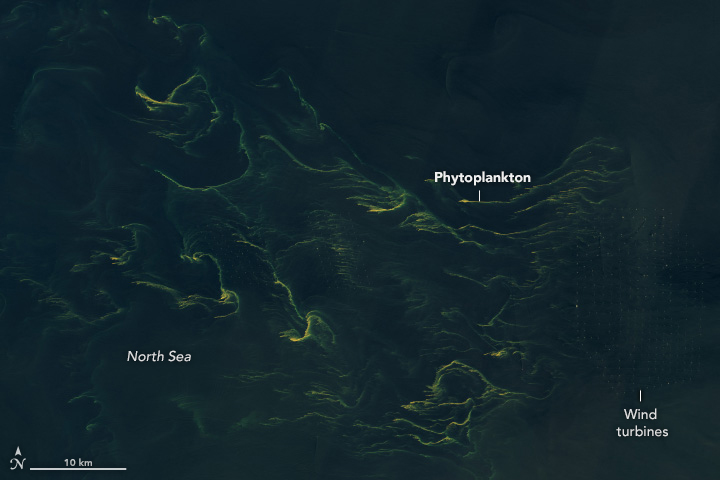
Noctiluca in the North Sea?
Downloads
- northseabloom_oli2_2023165_lrg.jpg (2492x1661, JPEG)
Metadata
- Sensor(s):
- Landsat 9 - OLI-2
- Data Date: June 14, 2023
- Visualization Date: June 16, 2023
Swirls and tendrils of color start to decorate the shallow waters of the North Sea in the spring and summer. Just as increasing sunlight and warmth triggers buds and blooms on land, it can also fuel blooms of the “grass of the sea”—phytoplankton.
On June 14, 2023, the Operational Land Imager-2 (OLI-2) on Landsat 9 acquired this natural-color image of a bloom north of the East Frisian Islands in Lower Saxony, Germany. The bloom became visible in natural-color MODIS imagery in late May and drifted in the area through mid-June. The grids of dots within and just east of the phytoplankton are turbines that are part of an offshore wind farm.
Phytoplankton are tiny, plant-like organisms that often float near the ocean surface and turn sunlight and carbon dioxide into sugars and oxygen. In turn, they become food for the grazing zooplankton, shellfish, and finfish of the sea. The also play an important but not fully understood role in the global carbon cycle, taking carbon dioxide out of the atmosphere and sinking it to the bottom of the ocean.
Phytoplankton are most abundant in the North Sea in late spring and early summer due to high levels of nutrients in the water. Melting sea ice and increased runoff from European rivers—a product of melting snow and spring rains—carry a heavy load of nutrients out to sea, while also freshening the surface waters. Intense seasonal winds blowing over the relatively shallow sea also cause a lot of mixing that brings nutrients to the surface.
Without a physical sample, it’s not possible to say for sure which type of phytoplankton are present in these images. However, the appearance of the blooms is similar to those created by Noctiluca scintillans—a type of marine dinoflagellate known to live in this area in the summer. Though Noctiluca scintillans blooms can glow at night in beautiful ways, their presence can also soak up oxygen from the water and cause hypoxia and dead zones.
NASA’s future Plankton, Aerosol, Cloud, ocean Ecosystem (PACE) satellite mission will allow researchers to infer more information about the oceans, such as the concentration and size of particles and dissolved organic materials, the diversity of phytoplankton, and rates of phytoplankton growth.
References
- Eggen, H. via Twitter (2023, June 11) Curious patterns on the southern North Sea. Accessed June 16, 2023.
- NASA Plankton, Aerosol, Cloud, ocean Ecosystem. Accessed June 16, 2023.
- NASA Earth Observatory (2019, October 7) Tracking “Blue Tear” Blooms. Accessed June 16, 2023.
- Royal Belgian Institute of Natural Sciences (2020) Impressive Noctiluca (Sea Sparkle) bloom in the North Sea. Accessed June 16, 2023.
- Ollevier, A. et al. (2021) Noctiluca scintillans: Dynamics, Size Measurements and Relationships With Small Soft-Bodied Plankton in the Belgian Part of the North Sea. Frontiers in Marine Science, 8.
- Piontkovski, S. (2021) Seasonal blooms of the dinoflagellate algae Noctiluca scintillans: Regional and global scale aspects. Regional Studies in Marine Science, 44.
- University of Tasmania Noctiluca scintillans. Accessed June 16, 2023.
NASA Earth Observatory image by Wanmei Liang, using Landsat data from the U.S. Geological Survey. Story by Adam Voiland.
This image record originally appeared on the Earth Observatory. Click here to view the full, original record.